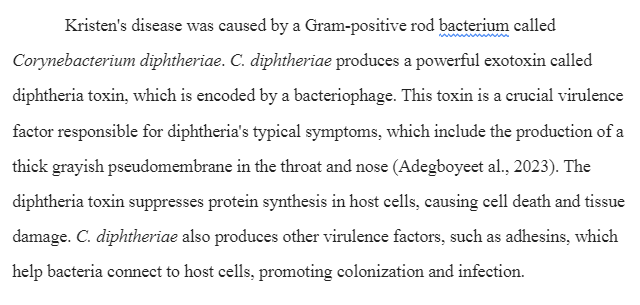Case Study on Diptheria
STEP 1: CHOOSE ONE OF THE FOLLOWING SCENARIOS TO RESEARCH:
1.The day after returning to school from being on vacation in the Dominican Republic, 8 year old Kristen was sent home after she complained of a sore throat and was determined to have a low-grade fever by her school nurse. Her parents kept her home from school the next two days as her sore throat continued to get worse. After these two days, her neck had swollen to the point where she was having a hard time breathing. Her parents took her to the ER where the doctors collected a swab of her throat, which identified Gram positive rod bacteria. As they examined her throat and nose, the doctors observed a thick layer of gray tissue coating both areas. While collecting a medical history, the parents told the doctors that Kristen had never received the standard childhood vaccinations as they had opted not to vaccinate for religious reasons.
2. Jeremiah is mid-way through his first semester of college in Maryland and has started pledging a fraternity. Three days after going for a hike in a nearby forest with some fraternity brothers and then attending a large party in the evening, Jeremiah wakes up with a fever and headache. He also notices his neck is stiff. He decides to take some Ibuprofen and tries to go to his first class of the day. After that class, he still isn’t feeling better so he goes back to his room to sleep it off. His roommate comes into the dorm room a few hours later and turns on the lights waking Jeremiah up and causing him to feel pain in his eyes. Jeremiah then proceeds to vomit into his trash can. His roommate tries to talk with him, but Jeremiah seems to be delirious and confused. The roommate takes Jeremiah to the campus doctor. After assessing the current symptoms, the doctor collects a blood sample and sends it out for culturing and diagnostic testing. The campus doctor also notices on Jeremiah’s record that he signed an affidavit stating he declined the standard entry vaccinations for reasons of conscience.
Case Study on Diptheria-3. Cameron and his family hosted a big party for the Superbowl with a large spread of different food. He made his famous hot chicken wings and ranch dip for the big game that were placed out early for a pre-game get together. After the game and once everyone left, Cameron noticed there were some leftovers of both remaining, so Cameron place them into the refrigerator. Cameron finished off both of them for lunch then next day. Three days later, Cameron started to have a headache followed by stomach pain and severe diarrhea. Cameron noticed that there was blood in his stool, so he scheduled an appointment with his family doctor. The doctor collected a stool sample and identified a Gram negative helical shaped bacteria. The doctor then sent the sample off for further culture-independent diagnostic testing.
CLUE: Each scenario is caused by BACTERIA (not a virus) and your diagnosis should accommodate ALL the symptoms given.
STEP 2: RESEARCH THE PATIENT’S SYMPTOMS TO DETERMINE WHICH PATHOGEN IS RESPONSIBLE AND ANSWER THE RESEARCH QUESTIONS GIVEN ABOVE.
- To do this scholarly research, you will be using the skills that you have practiced in the Case Study Skill Assignments. Be sure to choose reliable sources, read the sources thoroughly, take notes on their contents, then be sure to properly cite them in your paper using BOTH in-text citations AND a works cited page.
- Remember you need enough information to write a FULL PARAGRAPH answering each question above.
- TIPS:
- Use resources such as microbiology text books, encyclopedias, HCC Library databases (e.g. Pro Quest Biology, Pro Quest Nursing) journals and online medical and government (ie CDC) sites to research these questions.
- We highly suggest that you take notes from the sources and THEN write your paper from your notes. This will help you use YOUR OWN WORDS.
- Also, be sure to note which information came from which source so that you can properly cite the information in your report.
- Here is a web page from our HCC library to assist you with citation if you need it! https://howardcc.libguides.com/citing-rhLinks to an external site.
Case Study on Diptheria-STEP 3:WRITE YOUR REPORT
- Your report should be in paragraph form and SHOULD NOT INCLUDE THE QUESTIONS. Each paragraph of your report should answer a different question.
- Your report should contain proper grammar and punctuation.
- Be sure to italicize Genus and species.
- The report should not be longer than 3 pages double-spaced (not including the references page) and should contain AT LEAST 6 paragraphs (one answering each of the questions above).
- As you write, be sure to cite EACH sentence that contains information that you found in a source with an in-text citation like this (Author, year).
- At the end of the paper, you need to be sure to include a references section that contains all the sources you cited in the body of the paper (at least 4 sources, 1 of which must be a published source).
- After each reference, you need to include a reliability comment.
- For example, I believe this is a credible source because… it was written by a governmental agency and was peer reviewed.
There is an excellent example paper included in the Case Study Module so you can get an idea of what we expect.
STEP 4: GRADE YOUR OWN WORK USING THE RUBRIC
When your instructor grades your work, he/she will use the rubric attached to this assignment. To make sure you do not miss out on any points, use the rubric attached to grade your own work and then fix any deficiencies you find
STEP 5: SUMBIT YOUR WORK AS A FILE BELOW
You need to submit your report online (see below for instructions).
Answer Preview-Case Study on Diptheria-BIOL-107

